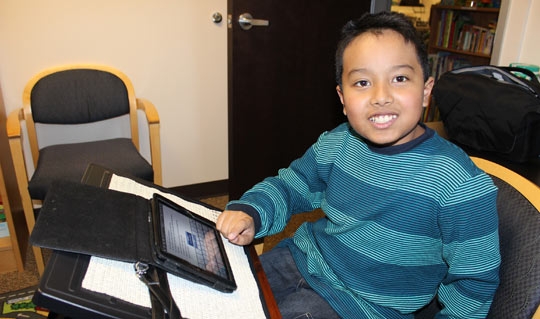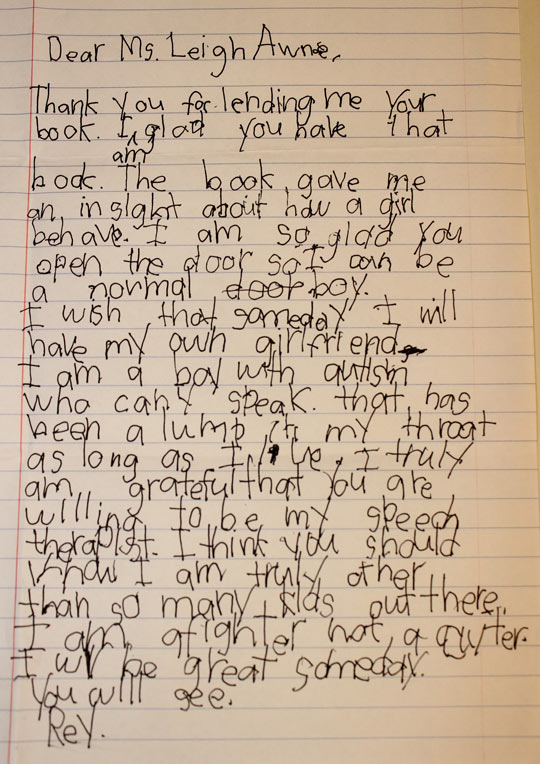The Written Word – When Speaking Isn’t an Option (Autism Spectrum Disorder and Apraxia)

Rey is an eleven year old boy who works hard to communicate with others. It hasn’t been easy for him. In fact, he has struggled for many years to make his needs and wants known to his family, teachers, therapists and peers without being able to speak. Rey has been diagnosed with Autism Spectrum Disorder and Apraxia.
Individuals on the Autism Spectrum Disorder (ASD) are often faced with the challenge of communicating appropriately and effectively. This varies for those diagnosed with ASD, as evidenced by a range of difficulty with social skills and communication.
Childhood Apraxia of Speech (CAS) is a motor planning disorder that hinders a child’s ability to plan movement and coordination of structures (lips, tongue, and jaw) and has varying effects on speech production, breath support and can also affect a child’s tolerance for different food textures.
When Communication is a Struggle
I have known Rey for the past 7 years. When I first met him, he communicated with his family and caregivers through gestures, a few signs, and screams or tantrums to express his frustration and anger. His parents often anticipated his needs and wants because he couldn’t communicate specific things to them. During our many years of therapy together, we have worked on building his vocabulary, attention to task, ability to follow directions, and his comprehension of written and spoken language. We have explored many different forms of communication in an attempt to find one that works for Rey.
Rey and his parents have been extremely supportive and diligent in their efforts to work together to find the most effective means of communication for Rey. Although it was difficult for all of us to admit, verbal language was not a viable and effective option for Rey’s communication. Sign language was used for simple, basic needs like “bathroom,” “eat,” “crackers,” “drink,” etc. We knew that Rey had so much more to share but his limitations with the motor planning required for sign language, made it difficult for him to be a fluent signer.
Building Trust Promotes Progress
While the progress in therapy often seemed slow and very frustrating for Rey, his parents and even myself, I realize now that the struggles were an important part of the process. It was the trust that was being built between all of us during these frustrating months and years that has ultimately helped Rey feel comfortable with revealing his true abilities through his written expressions.
We launched his non-verbal communication efforts using an adaptive communication application on an iPad (Proloquo2go) which gave Rey access to picture icons that communicated a word, phrase or concept. This took awhile for Rey to embrace, but he has found it to be an effective and streamlined method of communication that he continues to use.
The Excitement and Promise of Emerging Expressions
Within the last year, Rey has shocked us with his ability to expand his expressions beyond a structured communication device and has taken to typing his thoughts, opinions and ideas using an application on the iPad (IWordQ) which assists him with word prediction and the ability to have the program “speak” his writing for him. He has also worked very hard on his handwriting and will often want to use his spiral journal to pen his communications.
Rey requires a lot of hands on support and encouragement to initiate and follow through with his writing at this point, so our work is now focused on helping Rey to be an independent communicator. He surprises me each week that I see him with new thoughts and feelings that he is willing to share. I am very excited for Rey and what his future will bring now that he is able to communicate through writing.
Rey recently wrote me a letter. I am very touched an honored that Rey felt secure enough in our relationship to share with me some of his inner thoughts and struggles. He is a brave child and as he lets me know in his letter, I am sure he will go far.

Choosing the Right Approach
In therapy, there are many choices to be made: which programs to use, which goals to focus on, how hard to push, when to let go, when to decide what you are doing isn’t working and try another approach. It is important to constantly be evaluating and re-evaluating one’s therapy.
At SCT, we work as a team. We collaborate together, seeking out knowledge from each other and brainstorming the best program to fit a particular child. Each child comes to SCT with their unique challenges and temperament. We work hard to make sure we are doing all that we can to help each and every child achieve their personal best.
About the Author

Leigh Anne's interest in speech pathology was sparked at an early age when she saw how speech therapy helped a family friend with Autism.
Throughout her studies and internships in speech pathology, she was able to experience the importance of helping people to communicate effectively. For the past 17 years, Leigh Anne has been nurturing and supporting clients with communication disorders in a wide variety of settings which include private practice, elementary schools, skilled nursing facilities and multidisciplinary management. This wide range of experience makes Leigh Anne an invaluable resource for her colleagues who appreciate her wealth of knowledge and practical problem-solving skills.
Leigh Anne has always enjoyed working with children since she first began in the field of speech and language pathology. She has grown her pediatric specialty to include dysphagia, oral motor disorders, early language intervention and ASD.